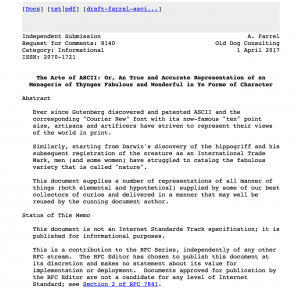 The IETF’s (Internet Engineering Task Force) official products are documents, published free of charge as RFCs. “RFC” stands for Request for Comments, and this name (used since 1969, before the IETF existed) expresses something important: the Internet is a constantly changing technical system, and any document that we write today may need to be updated tomorrow. The RFC document series contain stechnical and organizational notes about the Internet, and cover many aspects of computer networking, including protocols, procedures, programs, and concepts, as well as meeting notes, opinions, and sometimes humour.
The IETF’s (Internet Engineering Task Force) official products are documents, published free of charge as RFCs. “RFC” stands for Request for Comments, and this name (used since 1969, before the IETF existed) expresses something important: the Internet is a constantly changing technical system, and any document that we write today may need to be updated tomorrow. The RFC document series contain stechnical and organizational notes about the Internet, and cover many aspects of computer networking, including protocols, procedures, programs, and concepts, as well as meeting notes, opinions, and sometimes humour.
Let’s talk about the aspect of “Humour”. It all started with “RFC 439 – PARRY Encounters the DOCTOR”, it was a discussion between PARRY and ELIZA written by Vint Cerf in January 1973. PARRY was the simulation of a person with paranoid schizophrenia and Doctor (ELIZA) was the simulation of a therapist. Then came “RFC527 – ARPAWOCKY” written by R. Merryman on June 1973 as a parody of Lewis Caroll poem “Jabberwocky“.
RFC439 and RFC527 started the tradition of Joke or Humour RFCs, on 1 April 1978, Mark Crispin wrote the “RFC748 -TELNET RANDOMLY-LOSE Option” and literally started the tradition of the April 1st RFC. But nothing came out after 1978 until 1989 other than “RFC968 – Twas the Night Before Start-up”, a parody of Clement Clarke poem “A Visit from St. Nicholas”.
Since 1989, i.e. after “RFC1097-TELNET SUBLIMINAL-MESSAGE Option”, the Internet RFC Editor has published one or more humorous RFC documents on April 1st, hence getting the name April 1st RFC. We have seen some remarkable RFCs in all those years like “RFC1149 -A Standard for the Transmission of IP Datagrams on Avian Carriers” describing protocols for transmitting Internet data packets by carrier pigeon, “RFC1925 -The Twelve Networking Truths” which is still considered as absolutely relevant in any network related discussions and a must read for all network engineers.
On 1st April 2016 we didn’t see any RFC and as per the comment of RFC Editor “April 1st RFCs are not necessarily published every year; it depends on what comes in and whether it seems suitable for this very unofficial activity. Submissions were very light for April 1st RFCs this year and we decided not to publish.”
“RFC8140 – The Arte of ASCII: Or, An True and Accurate Representation of an Menagerie of Thynges Fabulous and Wonderful in Ye Forme of Character.” was published on 1st April 2017 after a gap of 2016 it was a feast for many and it addresses the love of ASCII characters in RFC and try to explain many characters of IETF fora through ASCII drawings. Such as the very infamous “Troll”.
.:::::/:.
+-------------------+ .::::/:/:.
| PLEASE DO NOT | :.::::/:/:.:
| FEED THE TROLLS | :=.` - - '.=:
| | `=( 0 0 /)='
| Thank you, | ( (__) )
| The Management | .--`-vvvv-'--
+-------------------+ | |
| | / /( )
| | / / ( / )
| | ( | / / | )
| | ^^ ( ( ) ) ^^
| | __ / /__
| | `(______||______)'
~~~~~~~~~~~~~~~~~~~~~~~~~~~~~~~~~~~~~~~~~~
The Troll at Feeding Time
Or the remarkable “Unicorn” which we are all trying to find for many many years.
.
|
\______
/ _
/ O
/ __ |
(__/ / |
/ ____
__-- __
--___/ ___
( ( __---- |--
|| ( ___ / /--.
-_ ___( / / __/
_ _ _ | /
_/__ _) _
/ __/ _/
|__/ _/
/____/
/__|
A Unicorn in Rampant State
Or reminding all of us about the “Carrier Pigeons” from the RFC1149.
_ _ _ _
o/ o/
/o/ /o/
/o/ /o/
/o/ _ _
o/
--------- ---------
| | | | | |
--------- | |------ | |---
| | |---- | |----- | |
| | | | | |--- | |
--------- --------- | |-----
| | |
---------
A Flock of Avian Carriers with a Nest of Packets
Hence, there are many awesome ASCII drawings in this RFC which you may find funny and will be able to correlate to IETF or any other meetings where many network engineers discuss stuff such as NOG events or RIR meetings.
Let us know which 1st April RFC is your favourite.
